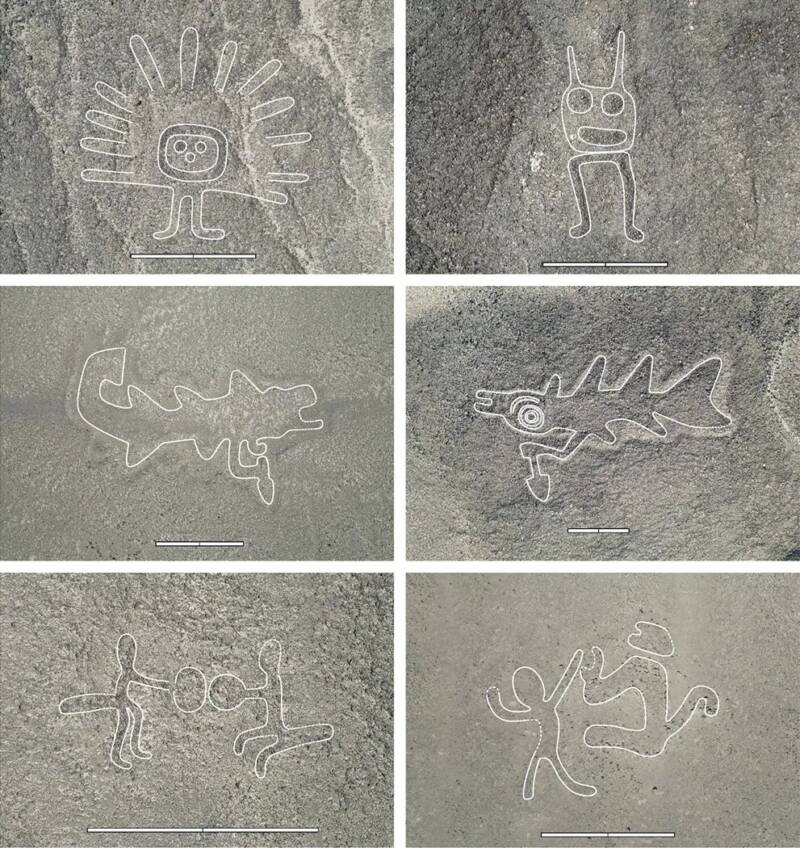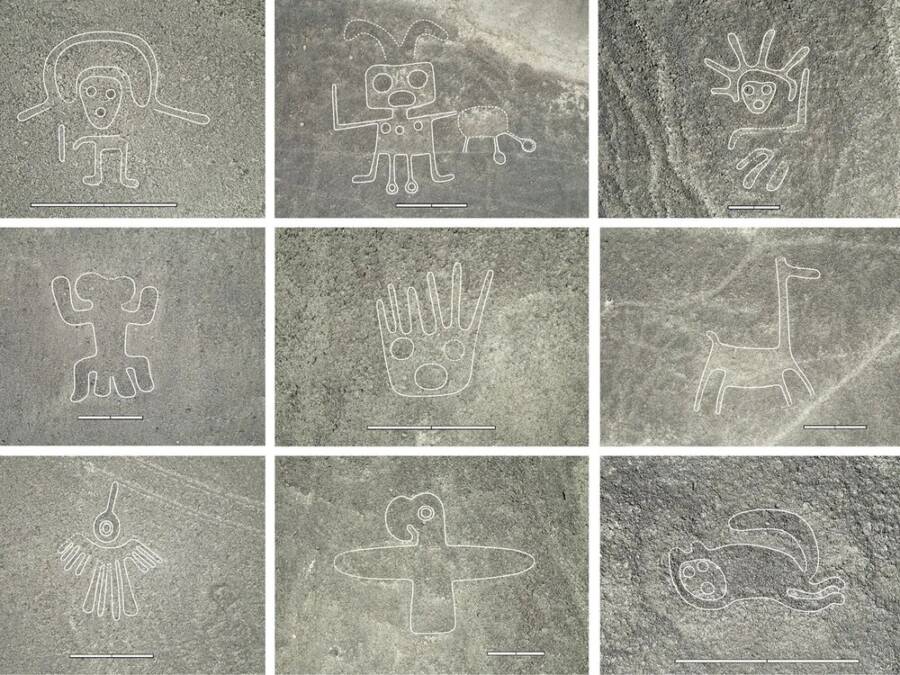The newly-discovered drawings include a decapitated head, a llama, and even a knife-wielding orca.

Masato Sakai et al./Proceedings of the National Academy of SciencesSome of the recently identified Nazca drawings include human-like figures, livestock, fish, cats, birds, and killer whales.
More than 2,000 years ago, the Nazca people etched lines, shapes, and figures into the deserts of southern Peru. Scientists rediscovered these geoglyphs in 1927, and over the past century, around 430 have been identified.
Recently, researchers identified an additional 303 geoglyphs with the help of artificial intelligence, nearly doubling the known number of Nazca drawings. This innovative use of A.I. is now demonstrating the potential for integrating new technology with traditional archaeology.
What Are The Nazca Lines Of Peru?
Scientists first discovered the Nazca Lines in the deserts of southern Peru in 1927. The sprawling geoglyphs were attributed to the Nazca culture, a pre-Inca civilization that settled along Peru’s Nazca River between roughly 200 B.C.E. and 600 C.E.
The Nazca people created their famous drawings by removing the reddish rock that covers the surface of the desert and revealing the lighter soil beneath. Many of the geoglyphs are huge, making the work of these ancient people even more impressive. Some of the straight lines are 30 miles long, while the larger animal figures can measure up to 1,200 feet in length — the height of the Empire State Building.

Diego Delso/Wikimedia CommonsNazca Lines in the shape of a monkey.
While researchers are unsure why the Nazca Lines were created, they may have served a spiritual purpose for the Nazca people. According to UNESCO, which declared the Nazca Lines an official World Heritage Site in 1994, the drawings “are the most outstanding group of geoglyphs anywhere in the world and are unmatched in their extent, magnitude, quantity, size, diversity, and ancient tradition to any similar work in the world.”
Although 430 lines and figures have been identified over the past century — including a giant cat in 2020 — scientists believe any others may be too faint for the human eye to pick out from satellite images. So, a team of researchers recently employed the help of A.I. to uncover more of the ancient drawings.
Artificial Intelligence Helps Identify New Nazca Lines
A study recently published in Proceedings of the National Academy of Sciences and led by Masato Sakai, an archaeologist at Japan’s Yamagata University, used A.I. technology to scan satellite images of Peru’s Nazca Desert. The A.I. model was trained to spot lines in the soil, no matter how faint, and it flagged any potential drawings 20 times faster than a human would be able to.
“The traditional method of study, which consisted of visually identifying the geoglyphs from high-resolution images of this vast area, was slow and carried the risk of overlooking some of them,” said Sakai, as reported by the Agence France-Presse.

Masato Sakai et al./Proceedings of the National Academy of SciencesThe identification of 303 new Nazca Line drawings nearly doubles the total number of known images.
Researchers then traveled to the sites flagged by A.I. and confirmed the existence of the Nazca Lines for themselves through drone photos and field inspections. In total, the team identified 303 new Nazca drawings, including plants, animals, and human-like figures.
However, they also uncovered a peculiar design: an orca holding a knife.
Scientists have seen a similar design before on Nazca pottery, suggesting orcas were culturally significant to the civilization.

Masato Sakai et al./Proceedings of the National Academy of SciencesA Nazca drawing of an orca wielding a weapon.
“On some pottery from the Nazca period, there are scenes depicting orcas with knives cutting off human heads,” Sakai told New Scientist. “So we can position orcas as beings that carry out human sacrifice.”
Now, researchers plan to review 250 additional images flagged by A.I. in hopes of adding to the growing number of Nazca Lines and revealing even more about the culture of the ancient Nazca people.
After reading about the newly-identified Nazca lines, explore 25 astonishing photos of the greatest Aztec pyramids. Then, read about how the Inca Empire fell at the hands of Spanish conquistadors.





